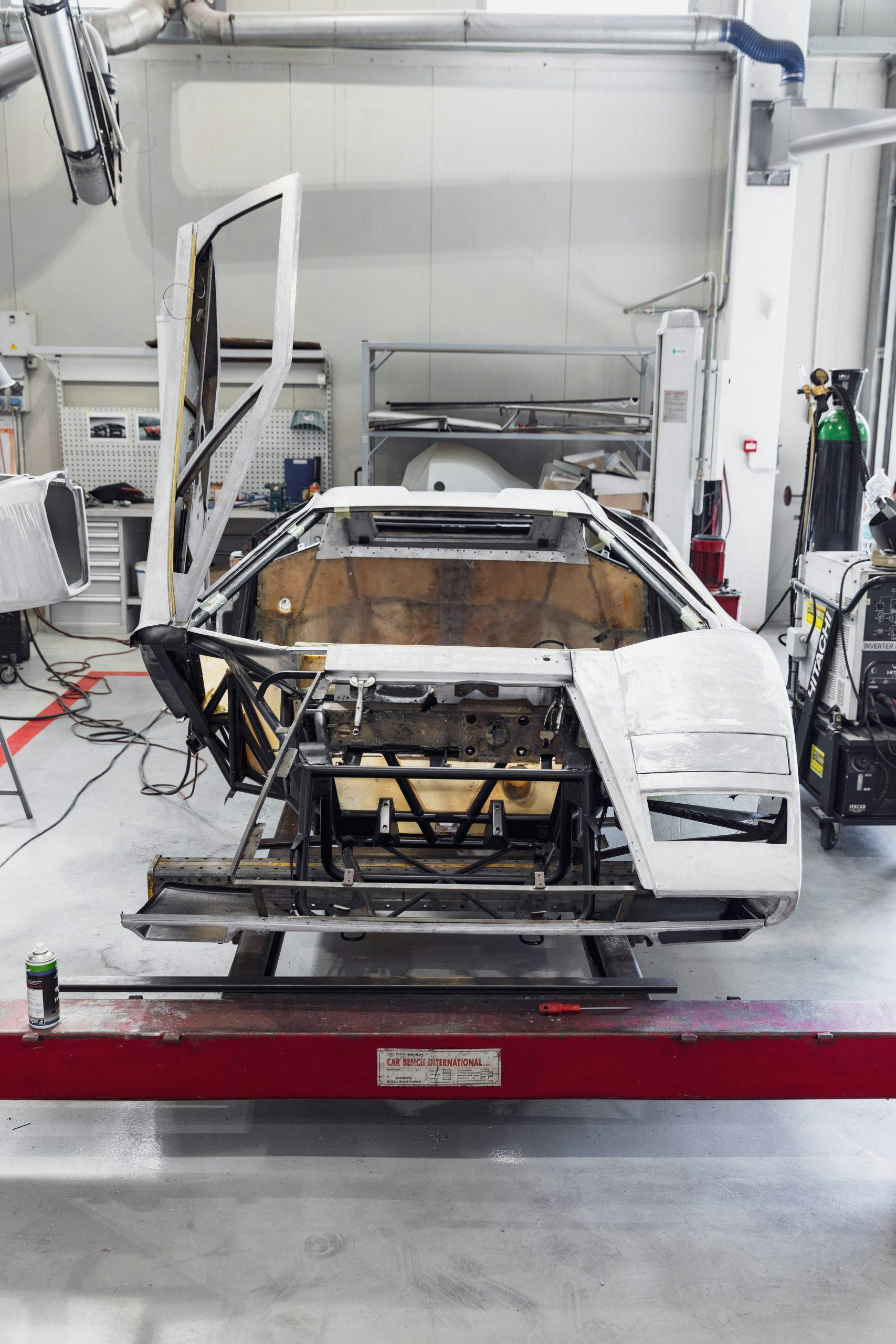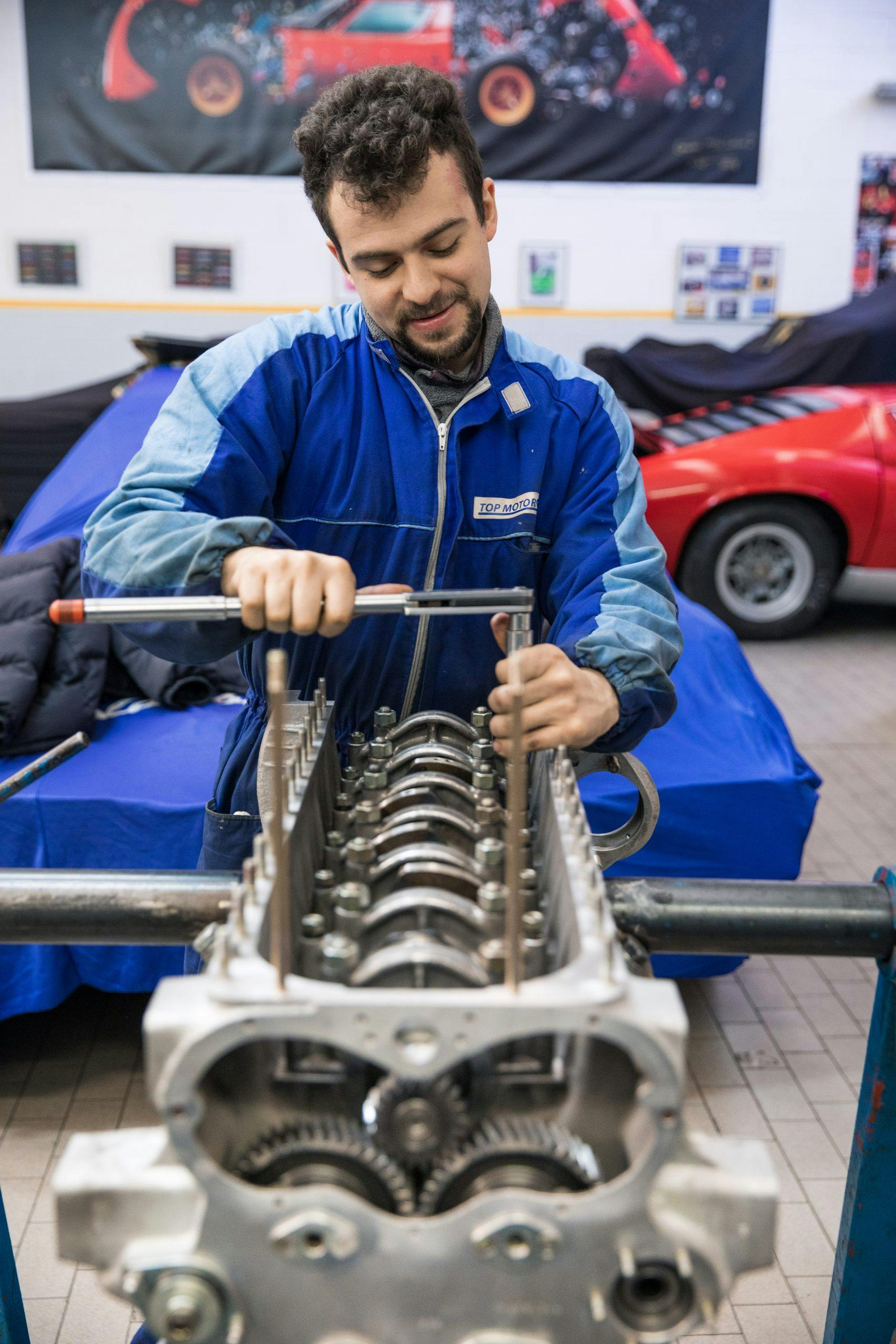Media | Articles
From wreck to dream drive: Simon Kidston’s astonishing $495,000 restoration of a one-of-a-kind Lamborghini Countach LP400
There is little that Simon Kidston doesn’t know about the classic car game. Having started as a “dogsbody” at Coys, the British auction house, he learned the trade, studied the cars, got to know the movers and shakers and ended up running Brooks, before setting up independently, in 2006. And because he’s seen it all before, nothing fazes the 52-year old when it comes to restoring classic cars.
Even the sight of a stoved-in Lamborghini Countach, which had taken an impact on the driver’s front side so heavy that it had flipped the car on to its roof and crushed the passenger’s A-pillar and roof until it was level with the dashboard, is not enough to deter Kidston – a man who once spent 28 years tracking down a Mercedes 300 SL, because it had family connections.
However, that wasn’t all there was to take in about the Lamborghini. The rare, 1977 LP400 model, the very first edition of the legendary Countach, had been gathering dust and a fair helping of rust, “somewhere in the Middle East” for more than 30 years, after the original owner mothballed it. That somewhere is reputed to be Bahrain; the original owner the nation’s ruler, Sheikh Isa bin Salman Al Khalifa. Unsurprisingly, Kidston is discreet, confirming only that the car was ordered by a member of a Middle Eastern royal family.
This was about the only positive piece of news about the project. Despite suffering a broken leg in the accident, the owner kept hold of the car, putting it to one side of their collection. Many would have parted company with an untamed supercar that had got the better of them in the heat of the moment. Chances are, it would have then been sold for parts.
Eventually, the owner sold it to a Middle Eastern dealership, which sent it away to Switzerland, where, oddly, an Aston Martin specialist was tasked with trying to restore the wreck. It didn’t go well.
Marketplace
Buy and sell classics with confidence
This is where Simon Kidston got involved. “They’d done a general job of it, but were still far from finished and the car was still in lots of bits, and were intent on changing it to candy-apple green, one of the early colors.” But as Kidston explains, the car’s rarity was in part not just that it was an early LP400, of which around 150 were made, but that it was the only one painted in Blu Turchese paint.
The nephew of the LP400’s original owner heard that all was not well with the restoration, contacted Kidston for advice and soon struck a deal, paying a little over the odds to bring the car back into the family and have the right people manage the restoration.
Wasn’t Kidston daunted? “I saw the car in person about a year ago. Before that, I saw photographs of it in its damaged state, and I thought, ‘Wow, that looks fantastic. What an amazing project.’” Clearly he wasn’t concerned that the already low-slung Countach had been flattened to knee-height.
The only Blu Turchese Countach LP400
For Kidston, the color was a dream come true. He says he has a thing for unusual colors—“yet another red Countach wouldn’t have been quite the same thing”—and that the turquoise blue was significant because it was both original and unique.
As for his list of the “right people” to carry out the restoration, that means the individuals who were involved in the creation of the Countach when it was new, and have, one way or another, continued to this day to work on the cars they so clearly admire.

Kidston has personally restored three LP400s in his time. Despite the first company’s attempts to put it right, the chassis still wasn’t straight, so Marchesi, in Modena, the original chassis builders contracted by Lamborghini, were instructed to set to work, using the very same jig that this car’s tubular steel spaceframe chassis would have been built on in period.
Next came the similarly delicate work required to get the bodywork right. This was carried out by Bacchelli & Villa, another Lamborghini subcontractor from the time of the LP400’s gestation. Together with Marchesi, the work has to be exacting not only to return to the original specification and have the car drive faithfully, but also ensure that the Countach’s signature design flourish, its scissor doors, dreamed up to raise two fingers at Ferrari, would fit perfectly.
The task of restoring the ragged, ripped and moldy interior was handed to Interni Auto, disciples of Bruno Paratelli, Lamborghini’s original master craftsman who trimmed the cars at the factory. As for the mechanical parts, including the magnificent, 4.0-liter V-12, that job fell to the Salvioli family (Orazio and Luca Salvioli) who oversaw servicing of the cars in period for the factory.
“The people who are restoring this car know these cars better, I believe, than anybody else in the world. The engine is in good condition, given it hadn’t done many miles before it was crashed,” says Kidston.
At the moment, the electrics are being worked on, and by the time final assembly is complete, the car will be have been in restoration, for the second time, for one and a half years.
How perfecting the doors gave the project closure
The greatest challenge, says Kidston, is the complexity of the Countach’s scissor door mechanism and fine tolerances required to ensure perfect fit, as there are a myriad of areas around the frame where the alignment could be out.
The other difficulty has been matching the car’s color. Because it was the only Blu Turchese to leave the factory, getting the paint color perfect involved a lot of toing and froing.
With any early Countach, there’s one more feature that cannot be ignored: the periscopio. Simply translating as periscope, it was designed to help the driver see behind them while driving one of the least practical, mid-engined supercars devised. Does it work?
“Not in the slightest!” chuckles Kidston. “It’s totally impractical. Lamborghini abandoned it before they’d even started. I think they probably commissioned all the bodies with that drawing already before they realized that it wouldn’t work and so they went ahead, at least for the early cars with that body system. You look back through a rear-view mirror when you’re driving and if you’re maneuvering, you sit on the sill of the car, and drive it almost as if you’re sitting on the wing of a tractor, which is perhaps not an entirely coincidental analogy with a Lamborghini.”

Everywhere a Countach goes, says Kidston, you get people of all ages commenting on how great it is to see the car out and about. “It generates even more surprise than a Miura, because of the sheer lines, the way the doors work, the impracticality.”
Having driven a Countach LP5000 QV, I can concur with what he says. The car draws fascination wherever it goes. But the weight of the controls—clutch, accelerator, brake pedal and steering—require no small level of commitment from the driver.
“It’s good at changing direction and the transfers of weight are good because the weight is very centralized in the car. It handles nicely although the rear tires are, surprisingly, a lot narrower than the last Miura’s, the SV. It’s said that’s because Lamborghini wanted to make use of the same wheels on both the Urraco and the Countach. It’s one of the things that Gandini says he regrets.
“I think it’s a fairly commonly held opinion that the early Countaches are infinitely more attractive. Certainly more pioneering and ground-breaking than the later ones, that become almost Liberace-esque. You know, spoilers and side slats and side skirts and so on. The early car is unadorned and pure. There’s no superfluous decoration, it’s like a perfect exercise in origami.”
Counting the cost

There are two more questions that cannot go unanswered when discussing a restoration as ambitious as this. The first, I expect Kidston to diplomatically swerve—how much will the project have cost?—but he is upfront. “All said and done it will have cost its owner between €400,000 and €500,000. You can certainly do it more cheaply, unquestionably. But I have never seen a Countach done to this standard, and I have seen some that have been butchered. It takes time to get right and you have to go to the people who know what it takes to build those cars, ideally from when they were young so it’s almost ingrained on them. It’s like the French concept of terroir, that food should come from the area where it’s produced and that there’s an appreciation and an understanding of it that you don’t find if you go out of the area.
“And I think the same is true very much of cars. I would never restore a Gullwing in Italy. And I wouldn’t restore a Duesenberg out of America, or a Corvette for example. I wouldn’t give an Italian restorer an Aston Martin. It just doesn’t seem historically right and there is not the same empathy for the object.” Little wonder the owner has visited throughout the restoration and met all those concerned.
As for the final question, it’s one that has kept conversations animated—be they at the pub or, lately, in a forum—ever since the Countach arrived on the scene, at the 1973 Geneva Motor Show. How do you pronounce the name?

“I spent a lot of time with people from Bertone and Lamborghini who were around the car at the beginning and although there’s no specific way it’s fair to say Koon-tash is the most common.”
And before we go, did you know where the car got its name? Valentino Balboni, Lamborghini’s former test driver, says that when Paolo Stanzani, managing director and father of the Miura, and Bob Wallace, test driver, were invited to Bertone’s studio to see the 1:1 scale model, they arrived late because of traffic, and everyone had left for the evening. However, a security guard had been told to expect the two visitors and instructed where to direct them. When he switched on the studio lights and saw the prototype, he cried out “Countach!” – wow!
As they left, Stanzani asked the guard, “What was the word you used to describe the car?”
“Countach!”
This article originally appeared here, on Hagerty’s U.K. website.







































